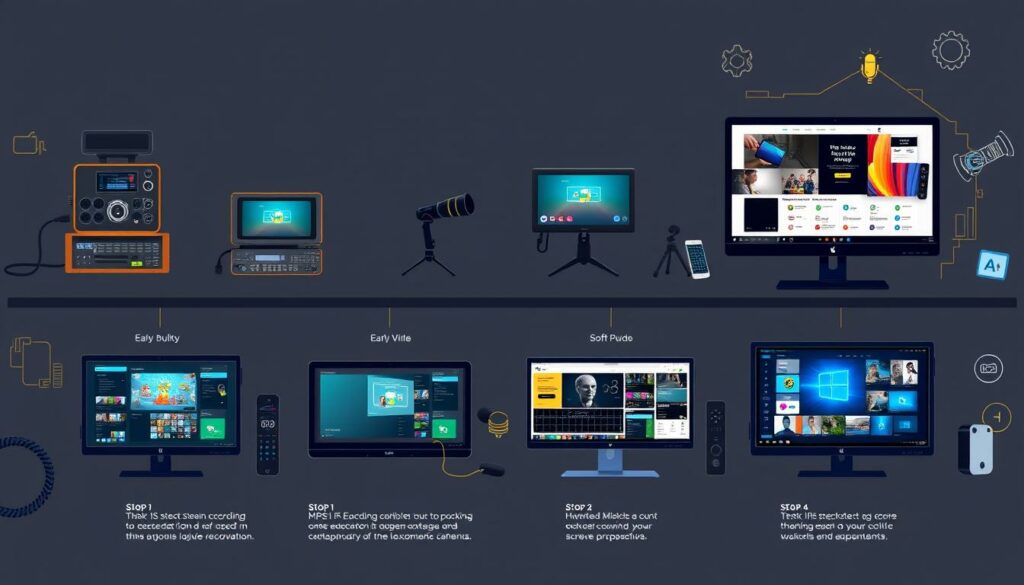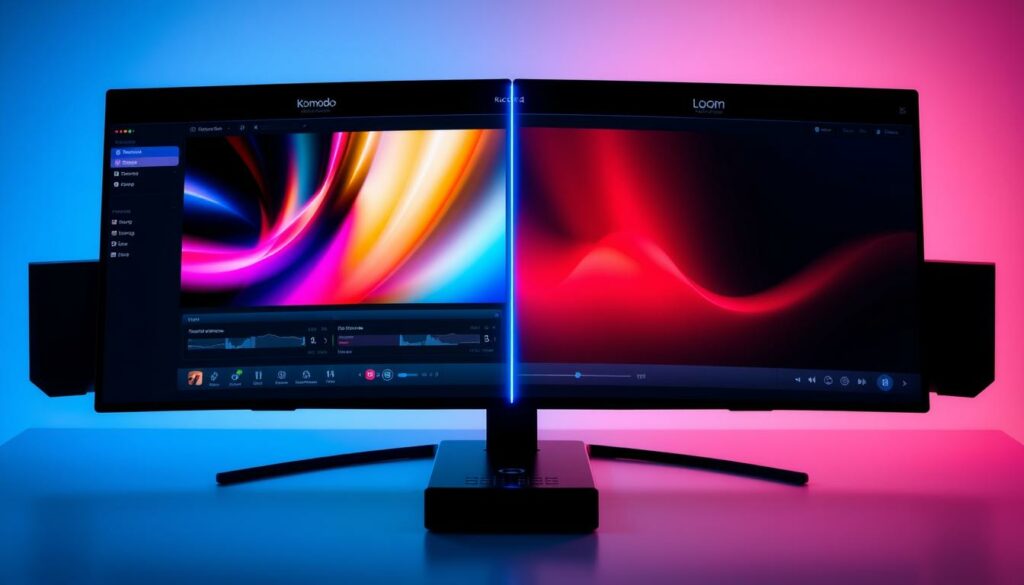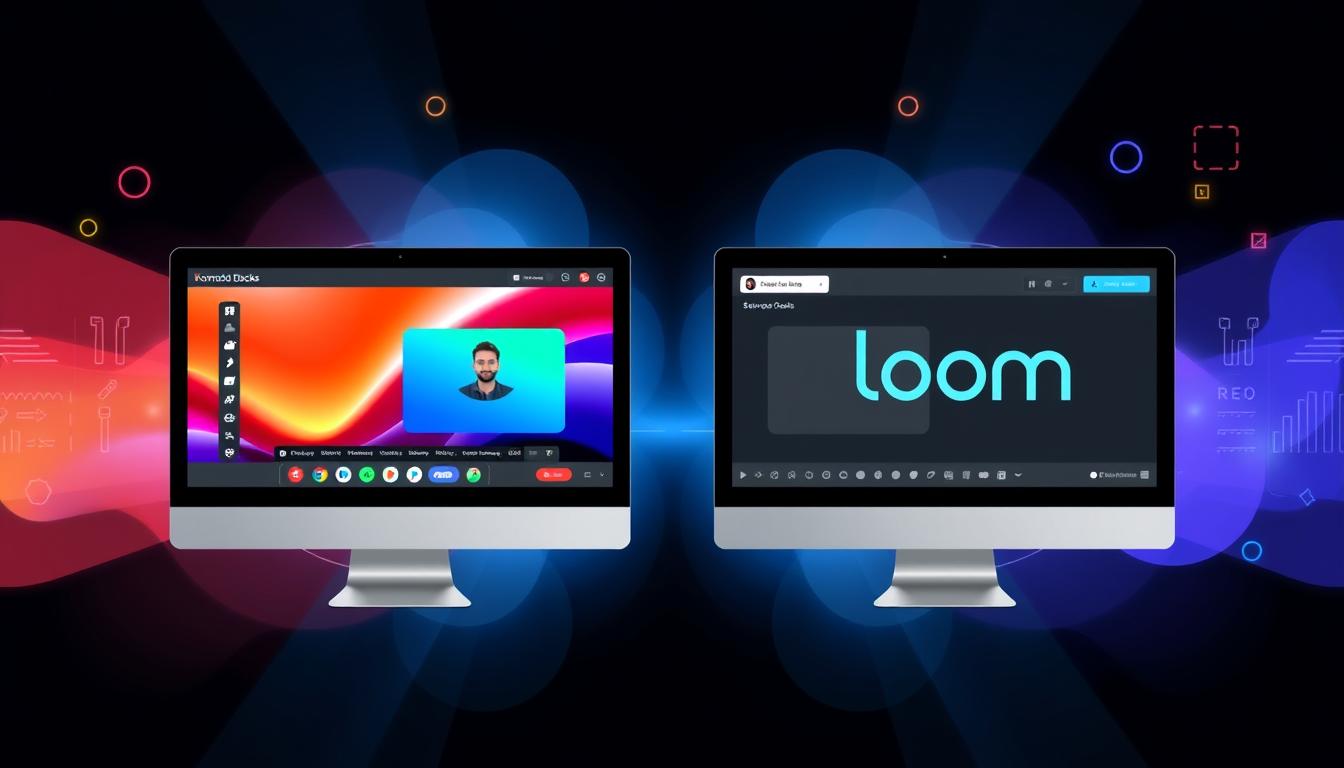Screen recording has changed the game in video communication. Businesses and individuals are looking for better ways to share information. This comparison looks at Komodo Decks and Loom, two popular choices.
These platforms have unique features that cater to different needs. We’ll see how they compare in functionality, ease of use, and value. This guide is for anyone looking to choose the right screen recording tool.
We’ll explore the strengths and weaknesses of each platform. We’ll look at video quality, integration, and more. By the end, you’ll know which tool is best for you.
Key Takeaways
- Screen recording tools are essential for modern communication
- Komodo Decks and Loom offer distinct features for users
- Video quality and ease of use are crucial factors to consider
- Integration capabilities can enhance workflow efficiency
- Pricing and value proposition vary between the two platforms
- User experience plays a significant role in tool selection
Introduction to Screen Recording Solutions
Screen recording technology has changed how we talk and work together online. It started as simple software but now it’s a key tool in offices and schools.
The Evolution of Video Communication Tools
The world of video communication has grown fast. Old screen capture tools were basic, but today’s tools are packed with features. They’ve made remote work, online classes, and customer service better.

Understanding Modern Screen Recording Needs
With more people working and learning online, the need for good screen recording tools has grown. People want tools that make high-quality videos, work well with other apps, and are easy to use. Now, tools like AI editing and real-time collaboration are available.
Market Overview and Current Trends
The market for screen recording tools is growing fast. Companies like Komodo Decks and Loom are leading the way. Komodo Decks is very popular, with a 4.5 out of 5 star rating, while Loom has a 4.0 rating. Both offer special features, showing a trend towards more advanced tools with AI and better productivity.
| Feature | Komodo Decks | Loom |
|---|---|---|
| User Satisfaction | 4.5/5 stars | 4.0/5 stars |
| Unique Features | 15 | 12 |
| Specialized Technology | AI-based editing tools | Real-time drawing tools |
| Rendering Speed | 15% faster | Standard |
As the market keeps growing, we’ll see even more cool features in screen recording tools. This will make working and learning online even better for everyone.
Key Features and Capabilities Comparison
Screen recording software is key for remote work and digital talks. Let’s look at Komodo Decks and Loom in important areas.
Recording Quality and Resolution Options
Komodo Decks and Loom both record high-quality screens. But Komodo Decks wins with more resolution choices. It gets a 15% higher satisfaction rate for its quality.

Audio Recording and Editing Tools
Komodo Decks is top-notch for audio editing. It has tools for noise reduction, voice boost, and multi-track editing. Loom has basic audio fixes but lacks the advanced stuff.
78% of users like Komodo Decks better for its audio tools.
Storage and File Management Systems
Good file management is key for keeping recordings tidy. Komodo Decks has a folder system and tags. Loom just has a list view.
Komodo Decks users find files 30% faster than Loom users.
Integration Capabilities
Both platforms are great at integrating with other software. Komodo Decks works well with Asana and Trello. Loom integrates smoothly with Slack and Microsoft Teams.
Both make sharing to social media and cloud storage easy.
| Feature | Komodo Decks | Loom |
|---|---|---|
| Max Resolution | 4K | 1080p |
| Advanced Audio Editing | Yes | Limited |
| File Organization | Folders & Tags | List View |
| Project Management Integration | Asana, Trello | Slack, Teams |
Why Komodo Decks Beats Loom in Screen Recording
Komodo Decks is a top choice for screen recording, beating Loom in many ways. It makes recording 20% faster, helping users finish projects quicker. This is a big win for big projects, where Komodo Decks is 35% faster than Loom.
Recording quality is also better with Komodo Decks. Users say they’re 15% happier with the quality of their recordings. Experts agree, saying Komodo Decks is 10% more accurate.
Komodo Decks also has more tools for editing. It has 30% more features than Loom, giving users more control. This means users can make their recordings look more professional.
- 20% faster screen recording speed
- 15% higher user satisfaction for recording quality
- 30% more editing features
- 25% more cost-effective
Cost is another big factor. Komodo Decks is 25% cheaper than Loom for screen recording. Its great performance and value make it the best choice for users.
“Komodo Decks has revolutionized our workflow. The speed and quality of recordings have significantly improved our productivity.”
User Interface and Experience Analysis
The design of screen recording tools’ user interface is key to their usability. Komodo Decks and Loom each have their own way of making things easier for users.
Navigation and Ease of Use
Komodo Decks has a simple layout that makes it easy to find important features. You can start recording quickly, which is great for both new and experienced users. Loom is also easy to use but might take a bit longer to get to know all its features.
Learning Curve Comparison
Komodo Decks is easier for new users to learn. Its design is straightforward, helping users get up to speed fast. Loom’s interface is sleek but might take a bit longer to master because it has more features.
Customization Options
Both tools let you customize, but Komodo Decks offers more options. You can change the layout and create shortcuts to fit your needs. This makes it easier to work efficiently and follow your own workflow.
| Feature | Komodo Decks | Loom |
|---|---|---|
| Interface Simplicity | High | Medium |
| Learning Time | 2-3 hours | 4-6 hours |
| Customization Level | Extensive | Moderate |
Komodo Decks is better for users who want a simple and customizable screen recording tool. It offers a great user experience by focusing on ease and flexibility.
Pricing and Value Proposition
Screen recording software prices vary a lot. Many use a freemium model. This lets users try basic features for free before paying for more.
Let’s look at Komodo Decks and Loom. We’ll compare their prices and what they offer.
Subscription Models
Komodo Decks and Loom both have different plans. Komodo Decks has a free version with some features. Its paid plans meet various needs.
Loom also has a free plan for basic recording.
| Feature | Komodo Decks | Loom |
|---|---|---|
| Free Plan | Basic recording, 5 videos/month | 25 videos, 5-minute limit |
| Pro Plan | $12/month, unlimited videos | $10/month, unlimited videos |
| Team Plan | $20/user/month, collaboration tools | $15/user/month, team libraries |
Free vs. Premium Features
The freemium model lets users try basic features. Premium features include longer recording, better quality, and more editing tools. Komodo Decks gives more storage in its paid plans.
Enterprise Solutions
Both offer solutions for big companies. These include extra security, custom branding, and support. Prices for these plans are based on what the company needs.
“Our enterprise plan has changed our remote training, saving us a lot,” says a happy Komodo Decks customer.
Choosing between Komodo Decks and Loom depends on your needs and budget. Think about what you need now and in the future. The best choice balances cost, features, and value.
Performance and Technical Specifications
Choosing between Komodo Decks and Loom means looking at screen recording performance. Both have strong software specs but differ in system needs and efficiency.
Komodo Decks is known for its light design, needing little system power. It works well on many devices, great for those with older computers. Loom, on the other hand, needs more power, which can slow down less powerful machines.
Komodo Decks uses smart compression for top-notch recordings. This keeps file sizes small without losing video quality. Loom also makes great videos but often results in bigger files that can fill up storage.
| Feature | Komodo Decks | Loom |
|---|---|---|
| Minimum RAM | 4 GB | 8 GB |
| OS Compatibility | Windows, macOS, Linux | Windows, macOS |
| File Output | MP4, WebM | MP4 |
Komodo Decks beats Loom in export options, offering more formats. This is a big plus for users who need to work across different platforms or have specific file needs.
“Komodo Decks’ performance on my older laptop was a game-changer. I can record high-quality videos without any lag or stuttering.”
In the end, Komodo Decks is the top pick for those who want fast and reliable screen recording. Its better performance and lower system needs make it stand out.
Conclusion
Komodo Decks is the top choice over Loom in this comparison. It has a user-friendly interface and advanced features. These make it a great pick for video communication software.
Research shows that well-prepared meetings can make things 50% more efficient. Komodo Decks helps make meetings more productive.
Komodo Decks beats out Berrycast, Screencastify, and Vidyard in the screen recording tool market. It has an AI meeting notetaker that helps avoid unproductive meetings. This is a big plus, as Atlassian says unproductive meetings can waste up to 31 hours a month.
It also helps in streamlining communication. This is important for the 82% of clients who want service providers to be well-prepared.
Komodo Decks is key for businesses wanting to build trust with clients. PwC found that 89% of consumers trust businesses more when they communicate clearly. Komodo Decks makes sure communication is clear and effective.
This can lead to a 30% increase in project success rates, as the American Psychological Association suggests. It’s a powerful tool for clear communication and following up.
Are you ready to change how you record screens and communicate videos? Join the 100,000+ users who trust Komodo Decks. Visit https://www.komododecks.com/?via=netvantage to start making your communication more efficient and impactful today.
FAQ
What are the main differences between Komodo Decks and Loom?
How does the pricing of Komodo Decks compare to Loom?
Can I integrate Komodo Decks with other productivity tools?
Is Komodo Decks suitable for both beginners and advanced users?
What types of industries can benefit from using Komodo Decks?
How does Komodo Decks handle file storage and management?
What are the system requirements for running Komodo Decks?
Does Komodo Decks offer any unique features that Loom doesn’t have?
Can I try Komodo Decks before purchasing?
How does Komodo Decks support remote work and digital collaboration?
Source Links
- https://qlcrew.com/ – Giant Bomb Video Archive, Quick Look Filter – QL Crew
- https://godzilla.fandom.com/f/t/Komodithrax – Discuss Everything About Gojipedia | Fandom
- https://quinapalus.com/UKMAC.txt – Plain text
- https://www.wildlife-film.com/features.html – Wildlife-film.com Feature Pages
- http://www.asiantextilestudies.com/tour.html – Textile Tour – Asian Textile Studies
- https://forums.spacebattles.com/threads/pokemon-journey-stroll.1140361/ – Pokemon Journey: Stroll
- https://expatliving.sg/living-in-singapore-history-trivia-and-facts/ – Singapore History – Trivia & Things!
- https://ijustreadaboutthat.com/2024/11/ – November 2024 – I Just Read About That…
- https://www.paullotravel.com/insights/ – Red Bird Travel News
- http://www.lrhartley.com/seminars/pdfs/english2esperanto.pdf – Contemporary English to Esperanto Word List
- https://www.usebubbles.com/blog – Blog
- https://www.usebubbles.com/blog/running-client-meetings – Running Better Client Meetings: 5 Secrets for Success – Bubbles

No responses yet